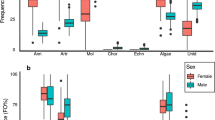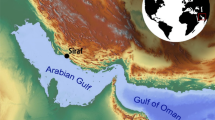Abstract
Identifying the geographic origins of Chinese mitten crabs is important for food safety and fair market competition. In this study, we used strontium (Sr) isotopes as a tool to trace the geographic origins of Chinese mitten crabs. Chinese mitten crabs, water, and different types of crab feed were collected from four different lakes for Sr isotope analyses. The results showed that the Sr isotope compositions of the different parts from one single crab were consistent within error, indicating that any piece of a crab could be used to represent the Sr isotope characteristics of the whole crab. The Sr isotope compositions of Chinese mitten crabs from the same lake were consistent within the analytical error, and the values were similar to the Sr isotope composition of the water from the same lake. However, the Sr isotope compositions of water and crabs from different lakes are significantly different. Therefore, the Sr isotope compositions of Chinese mitten crabs are mainly controlled by lake water composition, while the impact of feed is limited. This study provides an effective method for tracing the geographic origins of Chinese mitten crabs.




Similar content being viewed by others
References
Camin F, Bontempo L, Perini M, Piasentier E (2016) Stable isotope ratio analysis for assessing the authenticity of food of animal origin. Compr Rev Food Sci Food Saf 15(5):868–877
Capo RC, Stewart BW, Chadwick OA (1998) Strontium isotopes as tracers of ecosystem processes: theory and methods. Geoderma 82(1–3):197–225
Chen DW, Zhang M, Shrestha S (2007) Compositional characteristics and nutritional quality of Chinese mitten crab (Eriocheir sinensis). Food Chem 103(4):1343–1349
Dasch EJ (1969) Strontium isotopes in weathering profiles, deep-sea sediments, and sedimentary rocks. Geochim Cosmochim Acta 33(12):1521–1552
Denison R, Koepnick R, Burke W, Hetherington E, Fletcher A (1994) Construction of the Mississippian, Pennsylvanian and Permian seawater 87Sr/86Sr curve. Chem Geol 112(1–2):145–167
Faure G (1986) Principles of isotope geology. Wiley, New York
Fialho C, Banha F, Anastácio PM (2016) Factors determining active dispersal capacity of adult Chinese mitten crab Eriocheir sinensis (Decapoda, Varunidae). Hydrobiologia 767(1):321–331
Fortunato G, Mumic K, Wunderli S, Pillonel L, Bosset J, Gremaud G (2004) Application of strontium isotope abundance ratios measured by MC-ICP-MS for food authentication. J Anal At Spectrom 19(2):227–234
García-Ruiz S, Moldovan M, Fortunato G, Wunderli S, Alonso J (2007) Evaluation of strontium isotope abundance ratios in combination with multi-elemental analysis as a possible tool to study the geographical origin of ciders. Anal Chim Acta 590(1):55–66
Ghidini S, Ianieri A, Zanardi E, Conter M, Boschetti T, Iacumin P, Bracchi P (2006) Stable isotopes determination in food authentication: a review. Ann Fac Medic Vet Univ Parma 26:193–204
Graustein WC (1989) 87Sr/86Sr ratios measure the sources and flow of strontium in terrestrial ecosystems. In: Rundel PW, Ehleringer JR, Nagy KA (eds) Stable isotopes in ecological research. Springer, Berlin, pp 491–512
Gu SJ, Wang XC, Zhang JJ, Mao JZ (2014) Application of electronic nose in the identification and rating of Chinese mitten crab. China Fish Sci 21(1):108–117 (In Chinese)
Guo BL, Wei YM, Pan JR (2007) Application of isotope fingerprinting technology in traceability of food origin. Trans Chin Soc Agric Eng 23(3):284–289 (In Chinese)
Hegdahl T, Silness J, Gustavsen F (1978) The structure and mineralization of the carapace of the crab (Cancer pagurus L.) 3. The epicuticle. Zoolog Scr 6(3):215–220
Horn P, Schaaf P, Holbach B, Hölzl S, Eschnauer H (1993) 87Sr/86Sr from rock and soil into vine and wine. Zeitschrift für Lebensmittel-Untersuchung und Forschung 196(5):407–409
Hurst R, Davis T (1981) Strontium isotopes as tracers of airborne fly ash from coal-fired power plants. Environ Geol 3(6):363–367
Jenner G, Longerich H, Jackson S, Fryer B (1990) ICP-MS—A powerful tool for high-precision trace-element analysis in Earth sciences: evidence from analysis of selected USGS reference samples. Chem Geol 83(1–2):133–148
Kawasaki A, Oda H, Hirata T (2002) Determination of strontium isotope ratio of brown rice for estimating its provenance. Soil Sci Plant Nutr 48(5):635–640
Kelly S, Heaton K, Hoogewerff J (2005) Tracing the geographical origin of food: the application of multi-element and multi-isotope analysis. Trends Food Sci Technol 16(12):555–567
Lagad RA, Alamelu D, Laskar AH, Rai VK, Singh SK, Aggarwal SK (2013) Isotope signature study of the tea samples produced at four different regions in India. Anal Methods 5(6):1604–1611
Luo RJ, Jiang T, Chen XB, Zheng CC, Liu HB, Yang J (2019) Determination of geographic origin of Chinese mitten crab (Eriocheir sinensis) using integrated stable isotope and multi-element analyses. Food Chem 274:1–7
Meija J, Coplen TB, Berglund M, Brand WA, De Bièvre P, Gröning M, Holden NE, Irrgeher J, Loss RD, Walczyk T, Prohaska T (2016) Isotopic compositions of the elements 2013 (IUPAC Technical Report). Pure Appl Chem 88(3):293–306
Montgomery J, Evans JA, Wildman G (2006) 87Sr/86Sr isotope composition of bottled British mineral waters for environmental and forensic purposes. Appl Geochem 21(10):1626–1634
Palmer MR, Edmond JM (1992) Controls over the strontium isotope composition of river water. Geochim Cosmochim Acta 56(5):2099–2111
Philip Horwitz E, Chiarizia R, Dietz ML (1992) A novel strontium-selective extraction chromatographic resin. Solvent Extr Ion Exch 10:313–336
Pilgrim TS, Watling RJ, Grice K (2010) Application of trace element and stable isotope signatures to determine the provenance of tea (Camelliasinensis) samples. Food Chem 118:921–926
Pouilly M, Point D, Sondag F, Henry M, Santos RV (2014) Geographical origin of Amazonian freshwater fishes fingerprinted by 87Sr/86Sr ratios on fish otoliths and scales. Environ Sci Technol 48(16):8980–8987
Raczek I, Jochum KP, Hofmann AW (2003) Neodymium and strontium isotope data for USGS reference materials BCR-1, BCR-2, BHVO-1, BHVO-2, AGV-1, AGV-2, GSP-1, GSP-2 and eight MPI-DING reference glasses. Geostand Newslett 27(2):173–179
Techer I, Lancelot J, Descroix F, Guyot B (2011) About Sr isotopes in coffee ‘Bourbon Pointu’of the Réunion Island. Food Chem 126(2):718–724
Tommasini S, Marchionni S, Tescione I, Casalini M, Braschi E, Avanzinelli R, Conticelli S (2018) Strontium isotopes in biological material: A key tool for the geographic traceability of foods and humans beings. In: Gupta DK, Walther C (eds) Behaviour of Strontium in Plants and the Environment, vol 2018. Springer, Cham, pp 145–166
Tzeng W-N et al (2007) Misidentification of the migratory history of anguillid eels by Sr/Ca ratios of vaterite otoliths. Marine Ecol Prog Ser 348:285–295
Waight T, Baker J, Peate D (2002) Sr isotope ratio measurements by double-focusing MC-ICPMS: techniques, observations and pitfalls. Int J Mass Spectrom 221(3):229–244
Walther BD, Thorrold SR (2006) Water, not food, contributes the majority of strontium and barium deposited in the otoliths of a marine fish. Marine Ecol Prog Ser 311:125–130
Wang W, Xu C, Zhang WB, Ma XZ (2007) Comparative study on the morphological differences of four local populations of Eriocheir sinensis. Chin Agric Sci Bull 23(6):648–653 (In Chinese)
Zhang C, Li Q, Wu X, Liu Q, Cheng Y (2018) Genetic diversity and genetic structure of farmed and wild Chinese mitten crab (Eriocheir sinensis) populations from three major basins by mitochondrial DNA COI and Cyt b gene sequences. Mitochondrial DNA Part A 29(7):1081–1089
Zhao J (2014) Comparative study on morphology and element “fingerprint” of mitten crabs in different habitats (Master thesis). Nanjing Agricultural University (In Chinese)
Zhao J, Su YP, Liu HB, Chen XB, Yang J (2014) Geographical origin difference of elemental “fingerprints” in Chinese mitten crab Eriocheir sinensis from the same/different water systems. J Nucl Agric Sci 28(7):1253–1260
Zong W (2014) Quaternary sedimentary structure and lithofacies paleogeographic evolution on the east bank of Tai Lake (Master thesis). Chengdu University of Technology (In Chinese)
Acknowledgements
This work was financially supported by the National Key Research and Development Program of China, the project of ‘Source Identification and Contamination Characteristics of Heavy Metals in Agricultural Land and Products (2016YFD0800300), and by Natural Science Foundation of China (41721002). We gratefully thank Junxing Chen, Ruixia Bai, Jiayang Sun, Xuqi Chen, Nan Sun, and Yifan Li for help in sample preparation.
Author information
Authors and Affiliations
Corresponding author
Electronic supplementary material
Below is the link to the electronic supplementary material.
Rights and permissions
About this article
Cite this article
Yin, HM., Huang, F., Shen, J. et al. Using Sr isotopes to trace the geographic origins of Chinese mitten crabs. Acta Geochim 39, 326–336 (2020). https://doi.org/10.1007/s11631-020-00407-5
Received:
Revised:
Accepted:
Published:
Issue Date:
DOI: https://doi.org/10.1007/s11631-020-00407-5




